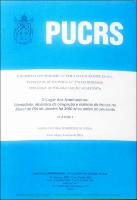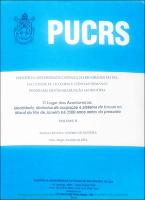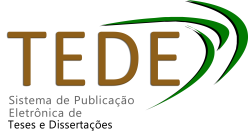| Share record |


|
Please use this identifier to cite or link to this item:
https://tede2.pucrs.br/tede2/handle/tede/11687| Document type: | Tese |
| Title: | O lugar dos aventureiros : identidade, dinâmica de ocupação e sistema de trocas no litoral do Rio de Janeiro há 3500 anos antes do presente - Volume I e Volume II |
| Author: | Oliveira, Maria Cristina Tenório de  |
| Advisor: | Hilbert, Klaus Peter Kristian |
| Abstract (native): | No presente trabalho, são abordadas três questões principais: identidade sociocultural; mobilidade e dinâmica de ocupação e sistemas de trocas. O enfoque principal está na Ilha Grande, no período de 3500 a 2500 anos AP. Como contorno, há a baía da Ilha Grande e de Sepetiba; como contexto, apresenta-se o litoral do estado do Rio de Janeiro e como pano de fundo, o litoral brasileiro do estado do Rio Grande do Sul ao estado do Espírito Santo. A pesquisa estruturou-se nos conceitos de análise espacial e de ecologia humana, acrescida do estudo do processo de formação de sítios sendo levada em consideração a crítica da arqueologia pós-processual. Associada a essas abordagens foram também testados modelos etnográficos para estabelecer relações válidas entre fenômenos arqueologicamente observáveis e comportamentos humanos, impossíveis de serem observados em termos arqueológicos. Parte-se do presuposto de que, no caso do litoral, os problemas na reconstituição das províncias culturais baseados no estudo da cultura material, podem ser minimizados se forem considerados os fatores de etnicidade e a possibilidade de ter havido intenso contato incentivado pelo transporte aquático e pelo tipo de atividades desenvolvidas para a subsistência. Conforme ferramenta para a inferência de identidade cultural, contato e sistema de troca, utilizaram-se, como traço cultural, os amoladores polidores fixos encontrados no litoral brasileiro. A grande incidência de amoladores polidores fixos encontrados na Ilha Grande estaria sugerindo a existência de centros de produção e de distribuição de lâminas de machados polidas e que o Holoceno tardio na costa do Rio de Janeiro poderia ter sido marcado pelo desenvolvimento de especialização tecnológica e intensificação dos sistemas de trocas. A reconstituição do processo de formação do sítio Ilhote do Leste, localizado na Ilha Grande, permitiu inferir a presença de eventos que envolviam uma concentração de um número maior de pessoas, corroborando esta hipótese. |
| Abstract (english): | Three queslions were approached in lhis work: socialcullural idenlily, mobility and dynamic of occupalion and syslems of changing. The main focus is in Ilha Grande belween 3.500 and 2.500 BP. As oulskirls lhere is Ilha Grande and Sepetiba bays; as conlexl there is the coast of Rio de Janeiro stale and as backdrop lhe brazilian coast since Rio Grande do Sul until Espírito Santo state. The research was framed on lhe concepts of spatial analysis and human ecology besides lhe sludy of formation process of lhe sites, laking inlo accounl the review of lhe pos-processual archaeology. Associated to these approaches, ethnographic models were also tested to stablish valid relations among phenomenons remarkable archaeolog·,cally and human behavior, which are impossible to observe under archaeological way. We believe that, in case of the coast, the problems to reconstitute the cultural province, based on the study of material culture, can be minimized if the factors of ethnicily and the possibility of intense conlact by aquatic transportation and by the kind of developed activities for subsistence were considered. The fixed grindstones, found on brazilian coas!, were used as toais to inter cultural identity, contact and system of exchange. Three questions were approached in this work: socialcultural identity, mobility and dynamic oi occupation and systems oi changing. The main locus is in Ilha Grande between 3.500 and 2.500 BP. As outskirts there is Ilha Grande and Sepetiba bays; as context there is the coast oi Rio de Janeiro state and as backdrop the brazilian coast since Rio Grande do Sul until Espírito Santo state. The research was lramed on lhe concepts oi spatial analysis and human ecology besides lhe study oi lormation process oi lhe sites, taking into account the review of the pos-processual archaeology. Associated to these approaches, ethnographic models were also tested to stablish valid relations among phenomenons remarkable archaeologically and human behavior, which are impossible to observe under archaeological way. We believe that, in case oi lhe coast, the problems to reconstitute lhe cultural province, based on lhe study oi material culture, can be minimized if lhe factors of ethnicity and lhe possibility of intense contact by aquatic transportation and by the kind oi developed activities for subsistence were considered. The fixed grindstones, lound on brazilian coast, were used as toais to infer cultural identity, contact and system of exchange. The great abundance of fixed grindstones, found in Ilha Grande, will be suggesting the existence of ash biades production and distribution centers and the late Holocene on Rio de Janeiro coast could be marked by development of technologic specialization and intensification of exchange system. The reconstitution of the formation process of the site llhote do Leste' situated in Ilha Grande, permitted to infer the presence of events which have involved a concentration with a great number of people, confirming this hypothesis. |
| Keywords: | Arqueologia do Litoral Sambaqui Ilha Grande Coastal Archaeology Shellmounds Ilha Grande |
| CNPQ Knowledge Areas: | CIENCIAS HUMANAS::HISTORIA |
| Language: | por |
| Country: | Brasil |
| Publisher: | Pontifícia Universidade Católica do Rio Grande do Sul |
| Institution Acronym: | PUCRS |
| Department: | Escola de Humanidades |
| Program: | Programa de Pós-Graduação em História |
| Access type: | Acesso Aberto |
| Fulltext access restriction: | Trabalho não apresenta restrição para publicação |
| URI: | https://tede2.pucrs.br/tede2/handle/tede/11687 |
| Issue Date: | 13-Feb-2003 |
| Appears in Collections: | Programa de Pós-Graduação em História |
Files in This Item:
| File | Description | Size | Format | |
|---|---|---|---|---|
| TES_MARIA_CRISTINA_TENORIO_DE_OLIVEIRA_COMPLETO_VOLUME_I.pdf | TES_MARIA_CRISTINA_TENORIO_DE_OLIVEIRA_COMPLETO_VOLUME_I.pdf | 10.06 MB | Adobe PDF |  Download/Open Preview |
| TES_MARIA_CRISTINA_TENORIO_DE_OLIVEIRA_COMPLETO_VOLUME_II.pdf | TES_MARIA_CRISTINA_TENORIO_DE_OLIVEIRA_COMPLETO_VOLUME_II.pdf | 13.5 MB | Adobe PDF |  Download/Open Preview |
Items in DSpace are protected by copyright, with all rights reserved, unless otherwise indicated.




